J Breast Cancer.
2012 Mar;15(1):105-110. 10.4048/jbc.2012.15.1.105.
Dose-Volume Analysis of Lung and Heart according to Respiration in Breast Cancer Patients Treated with Breast Conserving Surgery
- Affiliations
-
- 1Department of Radiological Science, Hanseo University, Seosan, Korea. jkkim@hanseo.ac.kr
- 2Department of Radiation Oncology, Samsung Medical Center, Sungkyunkwan University School of Medicine, Seoul, Korea.
- 3Department of Radiological Technology, Daewon University College, Jecheon, Korea.
- 4Department of Nuclear Engineering, Hanyang University, Seoul, Korea.
- KMID: 2286481
- DOI: http://doi.org/10.4048/jbc.2012.15.1.105
Abstract
- PURPOSE
Adjuvant radiotherapy of breast cancer using a photon tangential field incurs a risk of late heart and lung toxicity. The use of free breathing (FB), expiration breath hold (EBH), and deep inspiration breath hold (DIBH) during tangential breast radiotherapy as a means of reducing irradiated lung and heart volume was evaluated.
METHODS
In 10 women with left-sided breast cancer (mean age, 44 years) post-operative computed tomography (CT) scanning was done under different respiratory conditions using FB, EBH, and DIBH in 3 CT scans. For each scan, an optimized radiotherapy plan was designed with 6 MV photon tangential fields encompassing the clinical target volume after breast-conserving surgery.
RESULTS
The results of dose-volume histograms were compared using three breathing pattern techniques for the irradiated volume and dose to the heart. A significant reduction dose to the irradiated heart volume for the DIBH breathing technique was compared to FB and EBH breathing techniques (p<0.05).
CONCLUSION
This study demonstrated that the irradiated heart volume can be significantly reduced in patients with left-sided breast cancer using the DIBH breathing technique for tangential radiotherapy.
Keyword
MeSH Terms
Figure
Cited by 1 articles
-
Evaluation of Dose Reduction of Cardiac Exposure Using Deep-inspiration Breath Hold Technique in Left-sided Breast Radiotherapy
Joo-Young Jung, Min-Joo Kim, Jae-Hong Jung, Seu-Ran Lee, Tae-Suk Suh
Prog Med Phys. 2013;24(4):278-283. doi: 10.14316/pmp.2013.24.4.278.
Reference
-
1. Choi DH, Jin SY, Lee DW, Kim ES, Kim YH. A study on BRCA1/2 mutations, hormone status and HER-2 status in Korean women with early-onset breast cancer. J Korean Soc Ther Radiol Oncol. 2008. 26:65–73.
Article2. Cho H, Kim C, Park S, Oh M, Lee J, Ahn K. Clinical outcome after breast conserving surgery and radiation therapy for early breast cancer. J Korean Soc Ther Radiol Oncol. 2008. 26:204–212.
Article3. Mageras GS, Yorke E. Deep inspiration breath hold and respiratory gating strategies for reducing organ motion in radiation treatment. Semin Radiat Oncol. 2004. 14:65–75.
Article4. Moon SH, Kim TJ, Eom KY, Kim JH, Kim SW, Kim JS, et al. Radiation-induced pulmonary toxicity following adjuvant radiotherapy for breast cancer. J Korean Soc Ther Radiol Oncol. 2007. 25:109–117.5. Korreman SS, Pedersen AN, Aarup LR, Nøttrup TJ, Specht L, Nyström H. Reduction of cardiac and pulmonary complication probabilities after breathing adapted radiotherapy for breast cancer. Int J Radiat Oncol Biol Phys. 2006. 65:1375–1380.
Article6. Stranzl H, Zurl B. Postoperative irradiation of left-sided breast cancer patients and cardiac toxicity. Does deep inspiration breath-hold (DIBH) technique protect the heart? Strahlenther Onkol. 2008. 184:354–358.
Article7. Kim HJ, Jang WI, Kim TJ, Kim JH, Kim SW, Moon SH, et al. Radiation-induced pulmonary toxicity and related risk factors in breast cancer. J Breast Cancer. 2009. 12:67–72.
Article8. Moran JM, Ben-David MA, Marsh RB, Balter JM, Griffith KA, Hayman JA, et al. Accelerated partial breast irradiation: what is dosimetric effect of advanced technology approaches. Int J Radiat Oncol Biol Phys. 2009. 75:294–301.
Article9. Stranzl H, Zurl B, Langsenlehner T, Kapp KS. Wide tangential fields including the internal mammary lymph nodes in patients with left-sided breast cancer. Influence of respiratory-controlled radiotherapy (4D-CT) on cardiac exposure. Strahlenther Onkol. 2009. 185:155–160.
Article10. Lee R, Chung E, Suh H, Lee KJ, Lee J. Analysis of the movement of surgical clips implanted in tumor bed during normal breathing for breast cancer patients. J Korean Soc Ther Radiol Oncol. 2006. 24:192–200.11. The Korean Breast Cancer Society. Nationwide Korean breast cancer data of 2004 using breast cancer registration program. J Breast Cancer. 2006. 9:151–161.12. Kim SK, Shin SO, Kim MS. Radiotherapy treatment planning using computed tomography in breast cancer. Korean J Med Phys. 1992. 3:59–65.13. Pedersen AN, Korreman S, Nyström H, Specht L. Breathing adapted radiotherapy of breast cancer: reduction of cardiac and pulmonary doses using voluntary inspiration breath-hold. Radiother Oncol. 2004. 72:53–60.
Article14. Chie EK, Shin KH, Kim DY, Kim TH, Kang HS, Lee ES, et al. Radiation pneumonitis after adjuvant radiotherapy for breast cancer: a volumetric analysis using CT simulator. J Breast Cancer. 2009. 12:73–78.
Article15. Albuquerque KV, Glaser S, Gao M. Initial set-up reproducibility for prone breast irradiation (PBI): comparative clinical data with supine breast irradiation (SBI) for women with different body mass indices (BMI) -- role for IGRT. Int J Radiat Oncol Biol Phys. 2010. 78:3 Suppl. S235.
Article16. Topolnjak R, Sonke JJ, Nijkamp J, Rasch C, Minkema D, Remeijer P, et al. Breast patient setup error assessment: comparison of electronic portal image devices and cone-beam computed tomography matching results. Int J Radiat Oncol Biol Phys. 2010. 78:1235–1243.
Article
- Full Text Links
- Actions
-
Cited
- CITED
-
- Close
- Share
- Similar articles
-
- Comparison of Electron and X-Ray Beams for Tumor Bed Boost Irradiation in Breast-Conserving Treatment
- Follow-Up after Volume Replacement Using Acellular Dermal Matrix in Oncoplastic Breast-Conserving Surgery
- Comparison of Psychiatric Symptoms between Total Mastectomy and Breast Conserving Surgery in Breast Cancer Patients
- A Dosimetric Comparative Analysis of TomoDirect and Three-Dimensional Conformal Radiotherapy in Early Breast Cancer
- Radiation Therapy for Patiens with Early-Stage Breast Carcinoma Treated with Breast-Conserving Surgery



